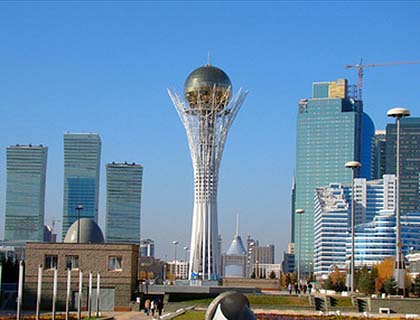There are a lot of countries in the region that are developing by various ways and have different achievements. But in our article we want to touch upon Kazakhstan which has its own model of development and has demonstrated to the whole world than in short time of independence one country can be recognized by international community as prosperous, friendly, peace-loving and stable state.
Let's take just a brief look to the Kazakhstan's achievements in the last 21 years. A full member of the United Nations and other authoritative international organizations, the successful chairmanship in the Organization for Security and Cooperation in Europe (2010). A member of the UN Council on Human Rights for 2013-2015. Construction of new capital - Astana. The right to hold the exhibition EXPO-2017. Moreover, the country has ninth largest country in the world by land area, virtually the entire periodic table in the bowels of the earth, the world's largest deposits of uranium, oil and gas which are being properly used for the nation's interests.
Could anyone say then, back in 1991, that Kazakhstan will achieve all of this during the years of independence? Nevertheless, it is. On December 16, 1991 the President of Kazakhstan Nursultan Nazarbayev signed the Constitutional Law "On the State Independence of the Republic of Kazakhstan." After the collapse of the Soviet Union, the Kazakh Soviet Socialist Republic was the last one in the post-soviet space which proclaimed sovereignty.
Independent state had to do a lot of basic steps to lay the foundation and give rise to the modern history of independent Kazakhstan, to create its own Constitution, introduce the national currency and found major government and public institutions. The first years of sovereignty were difficult for Kazakhstanis, and there were many reasons to doubt the success of the country's independence.
From the first days of its independence, Kazakhstan has appeared before the world as a truly peace-loving nation, responsible and consistent participant in the process of nuclear disarmament and strengthening global security. Repeatedly experienced the full impact of nuclear explosions, the country is unwavering in its desire to make the world safe and make impossible the proliferation of weapons of mass destruction.
The highest recognition in the international arena was brought to the country by "Kazakhstan model" of government. Strengthening national security, the Republic pays great attention to the internal political stability of society. In contrast to other post-Soviet countries, Kazakhstan, whose territory has approximately 130 different ethnic groups and religions, has managed to avoid strife between the people of the country and maintain internal stability.
Interfaith peace, peaceful interethnic interaction, balance between tradition and innovation are important factors in building a civil society and the preservation of statehood. "Our model of interethnic and inter-religious harmony - is Kazakhstan's contribution to the global process of the interaction of different faiths. We want to be perceived by the international arena exactly this way "- repeatedly said President Nursultan Nazarbayev.
Religious extremism in the republic does not have a social base, scale and scope, which could be a source of instability for the country and its neighbors. The recognition of the achievements of Kazakhstan in the field of interfaith relations in the country was holding of the forum of representatives of world religions.
Kazakhstan could not avoid collisions that he tried to warn other states. Just a year ago, world TV channels circled shocking footage riots in Western Kazakhstan town Zhanaozen. Whereas it seemed that the mass killings, the burning of municipal institutions and fights are starting another "color revolution".
In a short time Kazakhstan has managed not only to restore calm in the city, but also to find the origins of violence. All threads lead to fugitive Kazakh oligarchs, which have often betrayed their country. The purpose of the corrupt "actors" was to ignite ethnic and social hatred among the population, but it did not happen. These events in Zhanaozen only united the people and proved how ethnic and social strife is alien to Kazakhs.
It is interesting that almost two weeks before the Independence Day of Kazakhstan, on December 1st it was celebrated a new national holiday - the Day of the First President - Leader of the Nation.
Nursultan Nazarbayev has repeatedly said - "yes, during the independence years there were a lot of errors and excesses. But do not forget – it was no experience of transition from one political system to another". Even zealous guardians of world democracy cannot help admitting that Kazakhs really appreciate their leader and recognize his outstanding role in the life of each of them. This is not surprising. From little-known republic of the former Soviet Union, Kazakhstan has become a country, which is known around the whole world. In 2012, Kazakhstan's independence turned 21.
This is the age when a person becomes an adult. The Republic of Kazakhstan also celebrates this age. Certainly, modern Kazakhstan has a lot of socio-economic and political problems that the country will have to decide. Kazakhstan continues to move forward, and through trial and error, selects realities of development that best suit to Kazakhstan.
Kazakhstan builds a modern civil society, develops economic systems, cooperates with international partners. But the main factor of development is still active civil position of Kazakhstanis. Citizens of the country realize that the raise of the Kazakhstan's prestige depends on each of them. That is what called "the Kazakhstan's model".

